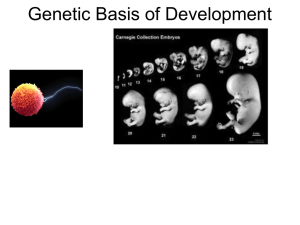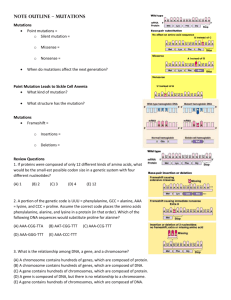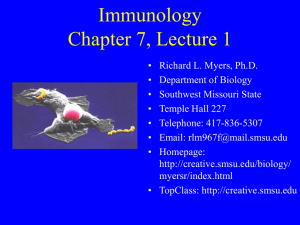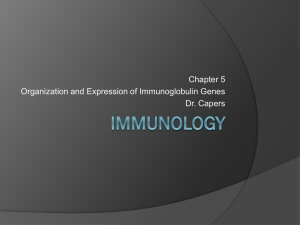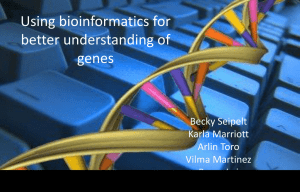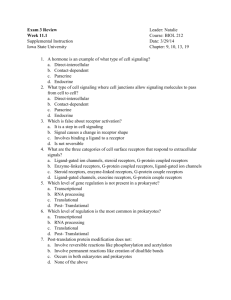Chapter 15 Controls over Genes
advertisement
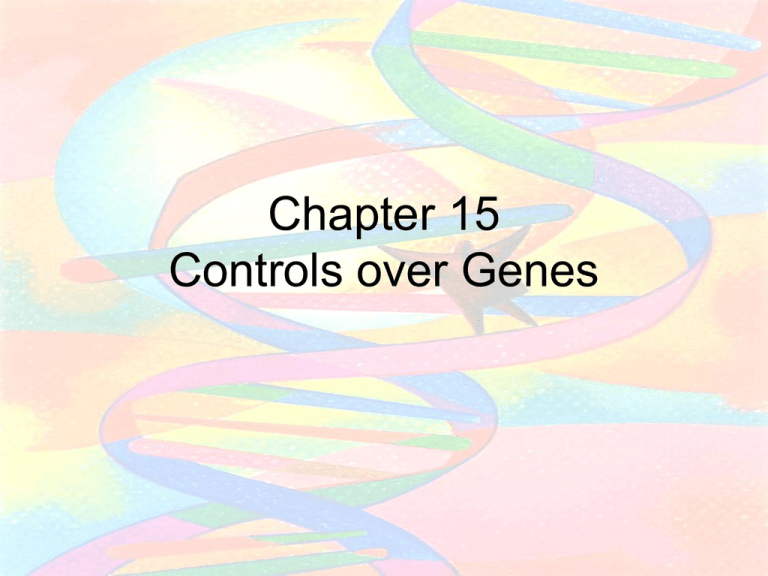
Chapter 15 Controls over Genes When DNA Can’t Be Fixed? • Changes in DNA are triggers for skin cancer, like the most deadly type– malignant melanoma • Cancers: are malignant forms of tumors – Neoplasm (tumors) are tissue masses that arise through mutations in the genes that govern growth and division – Malignant tumors grow rapidly causing destructive effects on surrounding cells Continue… • Gene controls are molecular mechanisms that govern when an how fast specific genes will be transcribed and translated Types of Control Mechanisms • Because all cells in your body have the same genetic instructions, only a relatively small amount number of genes are active at any given time in any given tissue – Which genes are expressed depends on the type of cell, its responses to chemical signals and built-in control systems Continue… • Regulatory Proteins intervene before, during or after gene transcription or translation – Regulatory proteins interact with DNA, RNA, or actual gene products Several controls system are used by cells: • Negative Control- a regulatory protein binds to the DNA to block transcription; it can be removed by an inducer – Slows down or curtail gene activity • Positive Control- a regulatory protein binds to the DNA and promotes initiation of transcription – Regulatory proteins promote or enhance gene activity Continue… • In chemical modification, regions of newly replicated DNA can be shut down by methylation and access to genes can be controlled by acetylation of histones proteins that organize DNA Negative Control of the Lactose Operon • E. coli bacteria (commonly found in the human digestive system) can metabolize lactose because of a series of genes that code for lactose-digesting enzymes – Three genes are preceded by a promoter and an operator – all together called an operon – Operator is a binding site for a repressor protein that can prevent gene transcription Continue… • A regulator gene nearby codes for a repressor protein that binds to the operator when lactose concentration are low and effectively block RNA polymerase’s access to the promoter • When milk is consumed, the lactose binds to the repressor changing its shape and effectively removing its blockage of the promoter; thus the RNA polymerase’s access can now initiate transcription of the genes Gene controls in eukaryotic cells • Much less is known about gene controls in multicelled eukaryotes because patterns of gene expression vary within and between body tissue Cell Differentiation and Selective Gene Expression • All body cells have the same genes, but the cells of different tissues are differentiated (specialized) because of selective gene expression Controls related to transcription include: (Brown Box p. 242) • Gene Amplication:DNA replicates hundreds or thousands of copies prior to transcription • DNA Rearrangements: Some genes have base sequences in the DNA, and they are put together in different ways to make different product molecules Continue… • Chemical Modification: histones and other proteins interact with eukaryotic DNA in organized ways. The DNA-protein packaging, plus chemical modifications to particular sequences Post-transcriptional controls • Transcript Processing: exons and introns • Transport Controls: dictates which mature transcripts will be shipped to the cytoplasm for translation • Post translational controls: govern the modifications to polypeptides • All found on p. 243 Figure 15-4 (b-d) Types of Control Mechanisms Homeotic Genes and Body Plans • Homeotic gene interact with one another and with control elements to brin about the formation of tissues and organs in accordance with the basic body plan. • These genes code for regulatory proteins that can bind to promoters and enhancers to control transcription X Chromosome Inactivation • In mammalian females, the gene products of only one X chromosome are needed the other is condensed and inactive ---called the Barr Body. • Because in some cells the parental X chromosome is inactivated while in other cells the maternal X chromosome is inactivated, each adult female is a mosaic of X-linked called mosaic tissue effect Continue… • This mosaic effect is seen in human females affected by anhidrotic ectodermal dysplasia in which a mutant gene on one X chromosome results in patches of skin with no sweat glands – Figure 15.6b and 15.7 -- page 245 Hormones Signals • Hormones are major signaling molecules that can stimulate or inhibit gene activity in target cells – Some hormones bind to membrane receptors on cells surfaces – Other enter cells to bind with regulatory proteins to initiate transcription, often with the aid of enhancer sequences Continue… • In the salivary glands of insect larvae, the polytene chromosomes responds to the hormones ecdysone by puffing out during transcription • In vertebrates, some hormones such as somatotropin have widespread effects because most of the body’s cells have receptors for it; whereas prolactin affects only the mammary glands Sunlight as a Signal • Plant seedlings will respond to a single burst of light by making chlorophyll • Phytochrome is a blue-green pigment that helps plants adapt to the changing light conditions of day/night and seasons by signaling genes responsible for germination, stem elongation, branching, leaf expansion, and formation of flowers, fruits, and seeds
